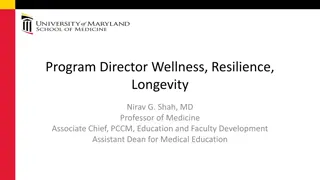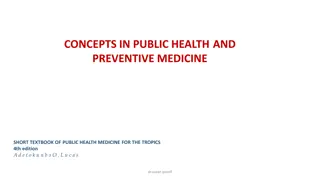Advancing Women's Leadership in Academic Medicine: A Focus on UFCOM
This presentation highlights the current status and future goals of women's leadership and advancement at UFCOM, focusing on the percentage of women faculty compared to national data, women's perceptions of advancement opportunities, and the importance of women in leadership roles. It discusses the benefits of having women leaders and presents data on the percentage of women at different ranks in the College of Medicine at both national and UF levels. The trends in the difference in percentages of women at various ranks between UF and national data over the years are also analyzed.
Uploaded on Sep 22, 2024 | 1 Views
Download Presentation

Please find below an Image/Link to download the presentation.
The content on the website is provided AS IS for your information and personal use only. It may not be sold, licensed, or shared on other websites without obtaining consent from the author.If you encounter any issues during the download, it is possible that the publisher has removed the file from their server.
You are allowed to download the files provided on this website for personal or commercial use, subject to the condition that they are used lawfully. All files are the property of their respective owners.
The content on the website is provided AS IS for your information and personal use only. It may not be sold, licensed, or shared on other websites without obtaining consent from the author.
E N D
Presentation Transcript
The Current Status and Future Goals of Women s Leadership and Advancement at UFCOM Sonal Tuli, MD, MEd
Background Background Few women Chairs at COM Status of women at other leadership positions not known Status of women at various ranks not known
Why Does This Matter? Why Does This Matter? Women leaders are more collaborative Better at problem solving and analyzing issues Better at communication Companies with more women in leadership financially outperform male dominated ones Better at conflict management
Specific Aims Specific Aims To compare the percentage of women faculty at the UFCOM to national data stratified by rank and leadership positions To gauge the perception of women faculty about the advancement and leadership opportunities available at UFCOM
National Data 2013 National Data 2013- -2014 2014 47% of Students 46% of Residents 38% of Faculty 21% of Professors 15% of Chairs 16% of Deans
Comparison of National and UF data for Percentage of Women at Different Ranks in the College of Medicine 45 National Assistant Professor Percentage of Faculty that are Women 40 UF Assistant Professor 35 National Associate Professor 30 UF Associate Professor 25 National Professor 20 15 UF Professor 10 2005 2006 2007 2008 2009 2010 2011 2012 2013 2014 2015
Trends in Difference Percentage of Women at Different Ranks Between UF and National Data 12 Difference between National and UF percent of women Assistant Professor Difference 10 Associate Professor Difference 8 Professor Difference 6 Linear (Assistant Professor Difference) Linear (Associate Professor Difference) Linear (Professor Difference) 4 2 0 2005 2006 2007 2008 2009 2010 2011 2012 2013 2014 2015
Percent of Women Faculty and Percentile Rank of UF 35 32.3 31.8 31.8 31.3 30 30.8 25 20 18 18 17 17 15 12 10 5 0 2012 2013 2014 2015 2016 Percent of Women Faculty Percentile Rank Compared to All Schools
Percentage of Chairs and Deans at UFCOM vs Nationally 35 30 25 20 15 10 5 0 Chairs Deans UFCOM Nationally
Perception of Women Regarding Perception of Women Regarding Advancement Opportunities Advancement Opportunities Faculty Forward survey Compared data significantly different between female and male respondents UF data will be similarly mined Town hall meetings planned in near future plan to make this one of the topics of discussion
AAMC Faculty Forward Survey Data AAMC Faculty Forward Survey Data Clear expectations about role and advancement path Regular feedback on performance Discussions clarifying promotion requirements Teaching and education Research and scholarship Well-defined roles and linkage of how day-to-day activities support the school s mission
AAMC data cont. AAMC data cont. An equitable and diverse workplace A workplace culture that cultivates diversity A workplace that is seen as offering equal opportunities to all faculty regardless of gender, race, and sexual orientation Environments that retain female and racial/ethnic minority faculty
AAMC data cont. AAMC data cont. Access to opportunities for development and advancement Increased availability of mentors and established mentoring programs Opportunities for advancement Professional development programming
We Are Equal Opportunity, Arent We? We Are Equal Opportunity, Aren t We? Barriers to Equal Opportunity Implicit Bias Imposter Syndrome
2012 study 6 prestigious universities 550 participants CV for lab manager position Differed only in 1 aspect name John vs Jennifer Jennifer scored statistically lower in all scales except likeability ( significantly higher) Salary offered was significantly lower for Jennifer
Imposter Syndrome Imposter Syndrome Syndrome where high achieving individuals chronically question their abilities and fear that others will discover them to be frauds Significantly more pervasive in women than men FP resident study 40% women & 20% men HP study men apply for jobs with 60% of qualifications met whereas women do with 100%
Implications for Women Implications for Women Job satisfaction lower Retention rate of women lower than men (leaving at higher rate than entering) Salary implications Starting salary about 16K less than comparable male colleagues Discrepancy widens with advancement Women don t negotiate expect fairness Advancement difference further widens gap Lifetime difference in millions
Next Steps? Next Steps? Search/promotion committees Make-up Awareness Mentorship Leadership program specifically for women Modified from free use image from interactioninstitute.org
References: References: Moss-Racusin CA, Dovidio JF, Brescoll VL, Graham MJ, Handelsman J. Science faculty's subtle gender biases favor male students. Proc Natl Acad Sci U S A. 2012 Oct 9;109(41):16474-9. Clance P, ImesS. The impostor phenomenon in high-achievingwomen: dynamics and therapeutic intervention. Psychotherapy: Theory, Research, and Practice 1978;15:241-7 Oriel K, Plane MB, Mundt M. Family medicine residents and the impostor phenomenon. Fam Med. 2004 Apr;36(4):248-52 Henning K, Ey S, Shaw D. Perfectionism, the imposter phenomenon and psychological adjustment in medical, dental, nursing and pharmacy students. Med Educ. 1998 Sep;32(5):456-64 https://implicit.harvard.edu/implicit/selectatest.html The State of Women in Academic Medicine: The Pipeline and Pathways to Leadership. AAMC 2014 Jagsi R, Griffith KA, Stewart A, Sambuco D, DeCastro R, Ubel PA. Gender differences in the salaries of physician researchers. JAMA. 2012;307:2410 2417.























